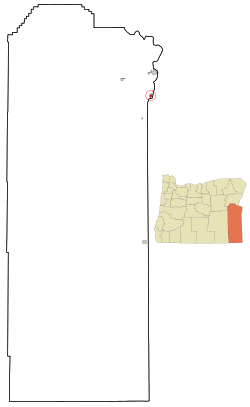Nyssa, Oregon facts for kids
Quick facts for kids
Nyssa, Oregon
|
|
|---|---|

Oregon Trail Agriculture Museum in Nyssa
|
|
| Nickname(s):
Thunderegg Capital of the World
|
|
| Motto(s):
Gateway to the Oregon Trail
|
|

Location in Oregon
|
|
| Country | United States |
| State | Oregon |
| County | Malheur |
| Incorporated | 1903 |
| Area | |
| • Total | 1.55 sq mi (4.01 km2) |
| • Land | 1.55 sq mi (4.01 km2) |
| • Water | 0.00 sq mi (0.00 km2) |
| Elevation | 2,192 ft (668 m) |
| Population
(2020)
|
|
| • Total | 3,198 |
| • Density | 2,063.23/sq mi (796.84/km2) |
| Time zone | UTC-7 (Mountain) |
| • Summer (DST) | UTC-6 (Mountain) |
| ZIP code |
97913
|
| Area code(s) | 541 |
| FIPS code | 41-53750 |
| GNIS feature ID | 1124870 |
| Website | www.nyssacity.org |
Nyssa (pronounced NISS-uh) is a city in Malheur County, Oregon, in the United States. It's located right on the border with Idaho, along the Snake River. This area is often called the "Treasure Valley."
Nyssa is known for its farming. Farmers here grow many crops like potatoes, sugar beets, onions, corn, and wheat. The city's economy depends a lot on these farms, with several large factories that package onions and potatoes.
Contents
History of Nyssa
Early Days and Native Americans
Long ago, the land around Nyssa was home to Native American tribes. The Northern Paiute and Cayuse tribes often visited this area. They found it a bit tough to live here because of the weather. An old fort called Fort Boise was built nearby in the 1830s.
Nyssa first became important as a place where sheep and other farm animals were shipped out. This happened because it was on the main train line of the Union Pacific railroad.
The Sugar Beet Industry
In 1935, a man named R. H. Tallman started trying to grow sugar beets in the area. His experiments worked really well! Because of this success, the Amalgamated Sugar Company built a factory in Nyssa. It started making sugar on October 9, 1938. The factory was built near the train lines and U.S. Route 20.
World War II and Labor Camps
During World War II in 1942, some Japanese Americans came to Nyssa to work in a farm labor camp. They had moved from their homes on the West Coast. Many of them chose to work at this camp to help with farming. The camp had about 100 canvas tents, each with a wood stove and a light bulb. There were also places for laundry and bathrooms.
About 400 people, including men, women, and children, worked at the Nyssa camp. They helped grow crops, especially sugar beets. Even though the camp wasn't fenced, the workers had a curfew and needed an escort to leave the camp. When winter came in November 1942, the tents were too cold. So, the camp closed, and most workers moved to other farms or found jobs in Eastern Oregon.
Later in the war, a special camp was set up for German and Italian prisoners of war. These prisoners came from a camp in Idaho. They also helped with the sugar beet industry, doing jobs like thinning and harvesting the crops.
Changes in the Sugar Industry
The Amalgamated Sugar Company owned and ran the sugar-processing plant in Nyssa from 1936 until 2005. This factory was the main business in the city for a long time. When it closed, about 600 seasonal jobs were lost. Even though the plant produced a lot of sugar, it was eventually taken apart. Now, sugar beets from Nyssa are sent to Nampa, Idaho for processing.
Geography
Nyssa covers an area of about 1.55 square miles (4.01 square kilometers). All of this area is land.
Climate
Nyssa has a semi-arid climate. This means it's generally dry, but not as dry as a desert. It gets some rain, but not a lot.
Population and People
| Historical population | |||
|---|---|---|---|
| Census | Pop. | %± | |
| 1910 | 449 | — | |
| 1920 | 563 | 25.4% | |
| 1930 | 821 | 45.8% | |
| 1940 | 1,855 | 125.9% | |
| 1950 | 2,525 | 36.1% | |
| 1960 | 2,611 | 3.4% | |
| 1970 | 2,620 | 0.3% | |
| 1980 | 2,862 | 9.2% | |
| 1990 | 2,629 | −8.1% | |
| 2000 | 3,163 | 20.3% | |
| 2010 | 3,267 | 3.3% | |
| 2020 | 3,198 | −2.1% | |
| U.S. Decennial Census | |||
How Many People Live Here?
In 2010, there were 3,267 people living in Nyssa. These people lived in 1,051 households, and 758 of those were families. The city had about 2,108 people per square mile.
Most people in Nyssa were White, and a large part of the population (about 60%) identified as Hispanic or Latino.
Many households (45%) had children under 18 living with them. About half of the households were married couples. The average household had about 3 people. The average age of people in Nyssa was about 30 years old.
Education
Students in Nyssa attend schools in the Nyssa School District 26.
Notable people
- John Bates, a football player
- Eva Castellanoz, an artist, activist, and educator
- Leo Long, an athlete
Images for kids
See also
 In Spanish: Nyssa (Oregón) para niños
In Spanish: Nyssa (Oregón) para niños



